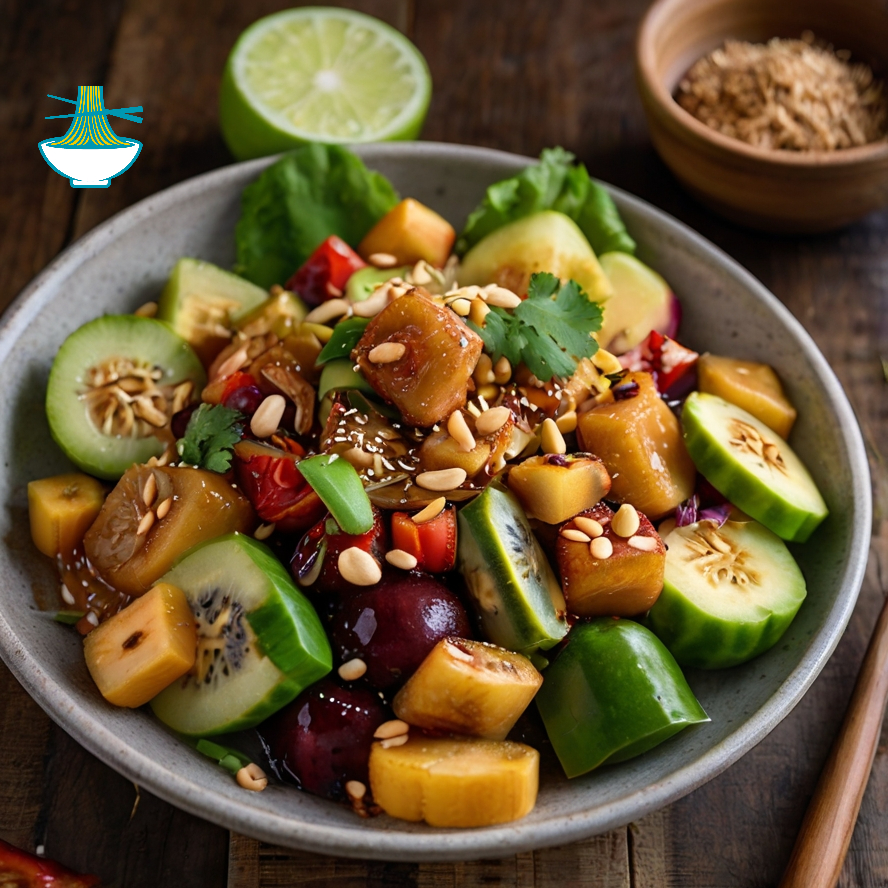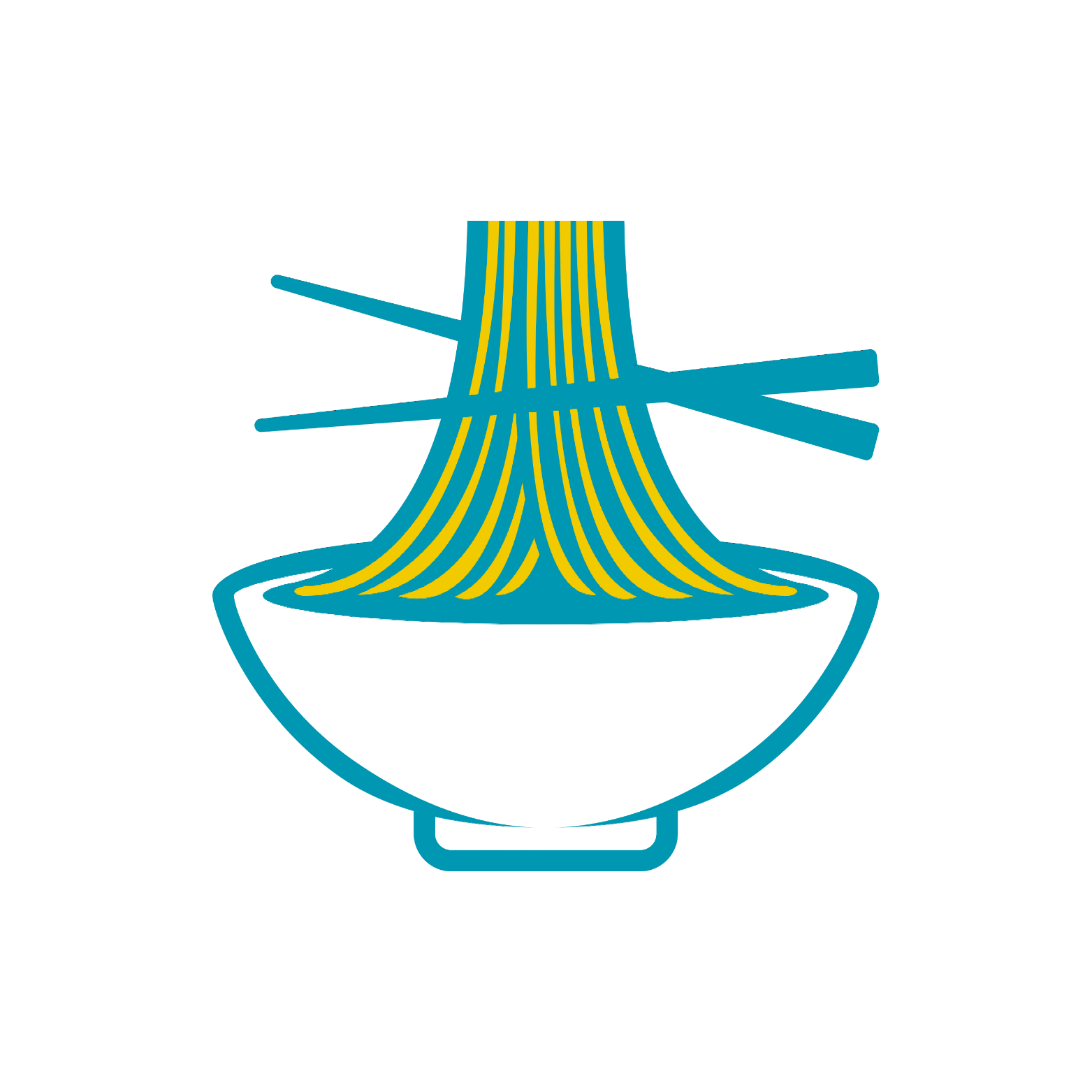Rojak is a popular Malaysian dish known for its vibrant combination of fruits and vegetables, drenched in a zesty peanut sauce. This refreshing salad not only satisfies your taste buds but also provides numerous health benefits. The fruits like pineapples and cucumbers are rich in vitamin C, which supports your immune system and skin health. Additionally, the peanuts in the sauce are a good source of protein, healthy fats, and vitamins, which promote overall well-being. However, one should be cautious of the high calories and sodium content, especially if consumed in large portions. Balancing this dish with other healthy foods can provide a nutritious, tasty meal while reaping its many health benefits.
Ingredients:
- 1 medium-sized pineapple, peeled and sliced
- 1 cucumber, sliced
- 1 apple, sliced
- 2 boiled eggs, sliced
- 1 cup of fried tofu cubes
- 1/2 cup of roasted peanuts
- 1 tablespoon of tamarind paste
- 1 tablespoon of sugar
- 1 tablespoon of chili paste
- 1 tablespoon of lime juice
- 1/2 teaspoon of salt
Instructions:
Step 1: Prepare the Ingredients
- Pineapple: Peel and core a fresh pineapple, then slice it into bite-sized chunks.
- Cucumber: Wash the cucumber thoroughly, cut off the ends, and slice it into thin rounds or small pieces.
- Apple: Choose a fresh apple (like Granny Smith or Fuji), wash it, core it, and cut it into bite-sized chunks.
- Boiled Eggs: Boil 2 eggs until fully cooked (about 10–12 minutes), cool them under running water, peel off the shells, and slice them into halves or quarters.
- Fried Tofu: Slice the tofu into small cubes and deep-fry them in hot oil until they are golden and crispy. Place them on a paper towel to drain excess oil.
Step 2: Prepare the Dressing
- In a small mixing bowl, combine the following ingredients:
- Tamarind Paste: Add 2 tablespoons of tamarind paste to create a tangy base.
- Sugar: Mix in 1–2 tablespoons of sugar to balance the tanginess. Adjust to taste.
- Chili Paste: Add 1 tablespoon of chili paste (or more if you prefer spicier flavors).
- Lime Juice: Squeeze in the juice of 1 fresh lime for a zesty kick.
- Salt: Add 1/2 teaspoon of salt to enhance the flavors.
- Stir the mixture thoroughly until the sugar dissolves and the dressing becomes smooth and well-blended.
Step 3: Combine the Salad Ingredients
- In a large serving bowl, combine the prepared pineapple, cucumber, apple, and boiled eggs.
- Add the fried tofu cubes to the mix. Gently toss the ingredients to ensure an even distribution.
Step 4: Toss with the Dressing
- Pour the prepared tamarind dressing over the salad ingredients.
- Use a large spoon or salad tongs to toss everything together, ensuring that the dressing coats all the ingredients evenly.
Step 5: Garnish and Serve
- Sprinkle a generous amount of roasted peanuts over the top for added crunch and flavor.
- Serve the salad immediately for the freshest taste and texture.
Tips for Best Results:
- Ingredient Substitutions:
- If tamarind paste is unavailable, substitute with a mix of lemon juice and a touch of honey for a tangy-sweet alternative.
- For a vegetarian option, skip the eggs or replace them with more tofu or roasted vegetables.
- Make-Ahead Option: You can prepare the dressing and chop the ingredients in advance. Keep them separate and mix just before serving to maintain the salad's freshness.
- Serving Suggestion: Pair the salad with iced tea or coconut water for a refreshing Malaysian-inspired meal.
Healthier Preparation
- Reduce calories and fat: Grill or bake the tofu instead of frying.
- Control sodium levels: Opt for low-sodium soy sauce and limit added salt in the dressing.
- Balance portions: Pair Rojak with a side of leafy greens to boost fiber content and satiety.
Cooking Tips
- For the perfect sauce texture: Gradually add water to the sauce while mixing to achieve a creamy consistency.
- To enhance peanut flavor: Roast the peanuts on low heat until golden brown and aromatic. Cool before grinding to preserve their oils and flavor.
FAQs
What is the origin and history of Rojak?
Rojak, a beloved dish in Malaysia, traces its origins to the rich blend of multicultural influences in Southeast Asia. The name "Rojak" itself means "mixture" in Malay, reflecting the dish's combination of diverse ingredients. Traditionally, it was a street food popular among traders and workers who valued its balance of flavors—sweet, spicy, and tangy. Over time, Rojak became a symbol of Malaysia's culinary diversity, with regional variations showcasing local produce and preferences.
What are the different types of Rojak across Malaysia and other countries?
There are several variations of Rojak, each with unique characteristics:
- Malaysian Rojak (Rojak Buah): Focuses on fresh fruits and vegetables, paired with a rich peanut sauce.
- Indian Rojak (Pasembur): Found in Penang, this version includes fried ingredients like fritters, boiled eggs, and seafood.
- Indonesian Rujak: Often sweeter, with ingredients like unripe mangoes, jicama, and a palm sugar-based dressing.
- Singaporean Rojak: Combines fruits and vegetables with fried dough fritters, bean sprouts, and shrimp paste.
How can the recipe be adapted for special dietary needs?
- For vegetarians: Simply omit the boiled eggs and ensure the peanut sauce does not include shrimp paste.
- For those with peanut allergies: Replace peanuts with sunflower seeds or almonds for a similar nutty texture and flavor.
- For low-sodium diets: Use a reduced amount of salt or replace it with natural herbs and spices to enhance flavor.
When is the best time to serve Rojak?
Rojak is incredibly versatile and can be served:
- As a light snack: Perfect for midday cravings.
- As an appetizer: Its vibrant flavors stimulate the palate before a main course.
- As a refreshing main dish: Especially on hot days when something light and nutritious is desired.

Nutritional values and benefits:
Pineapple (1 medium-sized)
- Calories: 450
- Carbohydrates: 115g
- Protein: 5g
- Fat: 1g
- Sodium: 10mg
- Vitamins: Vitamin C: 130mg (220% DV)
Nutritional Benefit: Pineapple is rich in vitamin C, which supports immune health and skin elasticity. The enzyme bromelain helps with digestion and inflammation reduction.
Cucumber (1 medium-sized)
- Calories: 45
- Carbohydrates: 11g
- Protein: 2g
- Fat: 0g
- Sodium: 10mg
- Vitamins: Vitamin K: 60mcg (50% DV)
Nutritional Benefit: Cucumber is hydrating, low in calories, and a good source of antioxidants. It supports digestion and helps reduce swelling and inflammation.
Apple (1 medium-sized)
- Calories: 95
- Carbohydrates: 25g
- Protein: 0g
- Fat: 0g
- Sodium: 1mg
- Vitamins: Vitamin C: 8mg (14% DV)
Nutritional Benefit: Apples provide fiber that aids in digestion and support heart health. Vitamin C boosts immunity and helps maintain healthy skin.
Boiled Eggs (2 large)
- Calories: 140
- Carbohydrates: 1g
- Protein: 12g
- Fat: 10g
- Sodium: 140mg
- Vitamins: Vitamin B12: 1.2mcg (20% DV)
Nutritional Benefit: Eggs are an excellent source of protein, essential amino acids, and vitamin B12, supporting muscle repair and energy production.
Fried Tofu (1 cup)
- Calories: 190
- Carbohydrates: 4g
- Protein: 18g
- Fat: 12g
- Sodium: 400mg
- Vitamins: Calcium: 350mg (35% DV)
Nutritional Benefit: Tofu is rich in plant-based protein and calcium, which support bone health, muscle repair, and overall vitality.
Roasted Peanuts (1/2 cup)
- Calories: 400
- Carbohydrates: 16g
- Protein: 16g
- Fat: 35g
- Sodium: 5mg
- Vitamins: Vitamin E: 7mg (50% DV)
Nutritional Benefit: Peanuts are high in healthy fats, protein, and vitamin E, promoting heart health, skin protection, and antioxidant activity.
Tamarind Paste (1 tablespoon)
- Calories: 30
- Carbohydrates: 8g
- Protein: 0g
- Fat: 0g
- Sodium: 0mg
- Vitamins: Vitamin C: 10mg (15% DV)
Nutritional Benefit: Tamarind is rich in vitamin C, which enhances immune function, and has digestive benefits that support gut health.
Sugar (1 tablespoon)
- Calories: 50
- Carbohydrates: 13g
- Protein: 0g
- Fat: 0g
- Sodium: 0mg
Nutritional Benefit: While sugar provides a quick source of energy, it should be consumed in moderation as it can contribute to blood sugar spikes and weight gain.
Chili Paste (1 tablespoon)
- Calories: 20
- Carbohydrates: 4g
- Protein: 1g
- Fat: 1g
- Sodium: 250mg
Nutritional Benefit: Chili paste provides capsaicin, which has anti-inflammatory properties and may boost metabolism, promoting fat burning and improving circulation.
Lime Juice (1 tablespoon)
- Calories: 4
- Carbohydrates: 1g
- Protein: 0g
- Fat: 0g
- Sodium: 1mg
- Vitamins: Vitamin C: 7mg (12% DV)
Nutritional Benefit: Lime juice is rich in vitamin C, supporting immunity, and it aids in detoxification and digestion.
Salt (1/2 teaspoon)
- Calories: 0
- Carbohydrates: 0g
- Protein: 0g
- Fat: 0g
- Sodium: 1,150mg
Nutritional Benefit: Salt is essential for maintaining fluid balance and nerve function, but it should be consumed in moderation to avoid high blood pressure and dehydration.


Comments